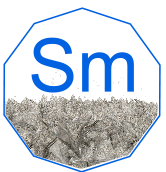Samarium

Samarium (Sm)
General Information
- Symbol: Sm
- Atomic Number: 62
- Atomic Weight: 150.36 u
- Element Category: Lanthanide
- Group: N/A (Lanthanides series)
- Period: 6
- Block: f-block
Physical Properties
- Appearance: Silvery-white metallic
- Density: 7.52 g/cm³
- Melting Point: 1072 °C (1962 °F)
- Boiling Point: 1794 °C (3261 °F)
- Phase at STP: Solid
- Electron Configuration: [Xe] 4f⁶ 6s²
- Oxidation States: +2, +3 (most common)
Chemical Properties
- Reactivity: Samarium is relatively stable in dry air but oxidizes in moist air, forming a samarium oxide layer. It reacts with water to form samarium hydroxide and with acids to form samarium salts.
- Compounds: Forms compounds such as samarium(III) oxide (Sm₂O₃), samarium(II) iodide (SmI₂), and samarium(III) chloride (SmCl₃).
Uses and Applications
- Magnets: Used in samarium-cobalt (SmCo) magnets, which are known for their high magnetic strength and resistance to demagnetization.
- Nuclear Industry: Used as a neutron absorber in nuclear reactors.
- Catalysts: Samarium compounds are used as catalysts in organic synthesis, particularly in the production of certain pharmaceuticals.
- Glass and Ceramics: Used as a coloring agent and in special glass and ceramics.
- Lasers: Samarium-doped calcium fluoride crystals are used in lasers.
Occurrence and Extraction
- Natural Occurrence: Found in minerals such as monazite and bastnasite, often alongside other rare earth elements.
- Extraction: Extracted through complex processes involving the crushing of ore, magnetic separation, and solvent extraction.
Isotopes
- Stable Isotopes: Samarium-144, Samarium-149, Samarium-150, Samarium-152, Samarium-154
- Radioactive Isotopes: Samarium-147 (used in research and medicine), Samarium-151
Safety and Handling
- Hazards: Samarium compounds are considered to have low toxicity, but dust and powders should be handled carefully to avoid inhalation or ingestion. Metallic samarium can be a fire hazard in powder form.
- Precautions: Use appropriate protective equipment when handling samarium and its compounds.
History
- Discovery: Discovered by Paul-Émile Lecoq de Boisbaudran in 1879.
- Name Origin: Named after the mineral samarskite, which in turn was named after the Russian mining engineer Vasili Samarsky-Bykhovets.
Additional Facts
- Crystal Structure: Rhombohedral
- Magnetic Properties: Paramagnetic
- Thermal Conductivity: 13.3 W/m·K
- Electrical Resistivity: 0.940 µΩ·m at 20°C
Summary
Samarium is a versatile lanthanide with a wide range of applications in industry and technology. It is particularly valuable in high-strength permanent magnets, the nuclear industry, and as a catalyst in organic synthesis. Discovered in 1879, samarium is named after the mineral samarskite. Samarium does not occur naturally in significant amounts and is typically found in minerals like monazite and bastnasite. Due to its relatively stable nature and low toxicity, it is considered safe to handle with appropriate precautions.
40 Question and Answer Pairs About Samarium
What is the atomic number of Samarium?
- 62
What is the symbol for Samarium?
- Sm
What is the atomic weight of Samarium?
- 150.36 u
In which group of the periodic table is Samarium found?
- Lanthanides series (no specific group)
What period is Samarium in?
- Period 6
What block does Samarium belong to?
- f-block
What is the density of Samarium?
- 7.52 g/cm³
What is the melting point of Samarium?
- 1072 °C (1962 °F)
What is the boiling point of Samarium?
- 1794 °C (3261 °F)
What is the electron configuration of Samarium?
- [Xe] 4f⁶ 6s²
What are the common oxidation states of Samarium?
- +2, +3 (most common)
What is the appearance of Samarium?
- Silvery-white metallic
Is Samarium reactive with air?
- Yes, it oxidizes in moist air to form a samarium oxide layer.
Name a compound of Samarium.
- Samarium(III) oxide (Sm₂O₃)
What is a common use of Samarium in magnets?
- In high-strength samarium-cobalt (SmCo) magnets.
How is Samarium used in the nuclear industry?
- As a neutron absorber in nuclear reactors.
What role does Samarium play in organic synthesis?
- Used as a catalyst in the production of certain pharmaceuticals.
How is Samarium used in glass and ceramics?
- As a coloring agent.
What is a chemical application of Samarium?
- Samarium-doped calcium fluoride crystals are used in lasers.
How is Samarium typically found in nature?
- In minerals such as monazite and bastnasite.
What is the most abundant isotope of Samarium?
- Samarium-152
What safety hazard is associated with Samarium dust?
- It can be a fire hazard.
Who discovered Samarium?
- Paul-Émile Lecoq de Boisbaudran
Where does the name Samarium come from?
- Named after the mineral samarskite.
What is the crystal structure of Samarium?
- Rhombohedral
Is Samarium paramagnetic or diamagnetic?
- Paramagnetic
What is the thermal conductivity of Samarium?
- 13.3 W/m·K
What is the electrical resistivity of Samarium at 20°C?
- 0.940 µΩ·m
What is the primary oxidation state of Samarium in its compounds?
- +3
Is Samarium found as a free element in nature?
- No, it is found in minerals.
What is the common name of Samarium(II) iodide?
- SmI₂
What is a major application of Samarium in the glass industry?
- Coloring agent.
How does Samarium benefit the nuclear industry?
- As a neutron absorber in reactors.
What is the melting point of Samarium in Kelvin?
- 1345 K
What group does Samarium belong to in the periodic table?
- Lanthanides series
What is the natural abundance of Samarium-152?
- It is the most abundant isotope.
Can Samarium be used in high-temperature applications?
- Yes, particularly in magnets and alloys.
What is the key property that makes Samarium valuable in magnets?
- Its ability to form high-strength, temperature-resistant magnets.
How is Samarium used in the chemical industry?
- As a catalyst in organic synthesis.
What precautions should be taken when handling Samarium?
- Use appropriate protective equipment to avoid inhalation or ingestion.






